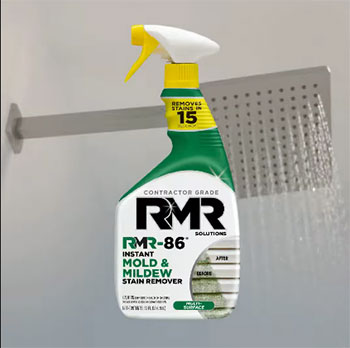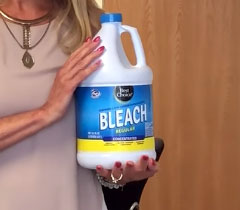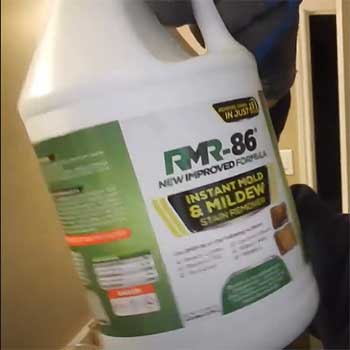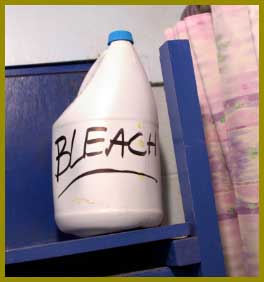Dealing with a mold outbreak?
Not all mold treatments are created equal. Let’s take a deep dive into two popular solutions: RMR-86 and bleach. We’ll explore their effectiveness, applications, and potential drawbacks to help you decide the best solution for your mold problems.
A Brief Comparison Table
| Factor | RMR-86 | Bleach |
| Formulation | Proprietary blend designed for mold and mildew stain removal | General-purpose disinfectant, cleaner, and whitener |
| Mechanism of Action | Breaks down the pigmentation of the mold stains instantly | Whitens the visible mold and kills some surface-level spores |
| Application & Versatility | Can be used on various surfaces; ready to use out of the box | Works best on hard, non-porous surfaces; requires dilution before use |
| Cost & Availability | More expensive and not as widely available as bleach; can be ordered online | Cheaper and widely available in most supermarkets or convenience stores |
| Safety | Requires precautions like gloves and good ventilation; generally safe for materials | Can produce harmful fumes; can cause discoloration or damage to certain materials |
| Long-Term Efficacy | Excellent at removing mold stains; does not necessarily kill the mold or prevent re-growth | Can kill surface-level mold and some types of spores; effectiveness limited on porous materials where mold can be deep-seated |
How RMR-86 Works to Kill and Prevent Mold
RMR-86 is a mildly alkaline mold killing solution and long-term mold preventative. The active ingredient in RMR-86 is potassium hydroxide, an alkaline salt.

When applied to a surface, RMR-86 raises the pH, creating an inhospitable environment for mold. Mold thrives in acidic conditions around pH 5-6. RMR-86 alters the pH to approximately 11, effectively killing mold spores on contact.
In addition to the high pH alkalinity, RMR-86 contains a bacteriostat which prevents future mold growth. The antimicrobial effects of RMR-86 can prevent mold regrowth for up to one year after application.
RMR-86 works against all common household molds including black mold, pink mold, gray mold, and powdery mildew. Field tests show RMR-86 eliminates over 99% of dangerous mold species.
Unlike bleach cleaners which only kill surface mold, RMR-86 can penetrate porous materials like drywall and wood to kill mold roots growing internally. This helps prevent mold from recurring in problematic areas.
How Bleach Works to Kill Mold
Bleach works through an entirely different mechanism than RMR-86. The active ingredient in bleach is sodium hypochlorite, which kills mold and other microbes through oxidation.
As sodium hypochlorite dissipates, it releases chlorine which disrupts proteins and enzymes in mold cells. This prevents mold spores from thriving and spreading.

Bleach is considered a disinfectant because it neutralizes many common bacteria and viruses through the same oxidation process. However, bleach does not provide any residual mold prevention after application.
Bleach is effective at killing mold on non-porous surfaces like tile, metal, and sealed concrete. But it has difficulty penetrating and killing mold roots growing inside drywall or wood.
Additionally, dead mold material can act as food for new mold growth. So bleach may kill surface mold but unless the dead spores are also removed, mold can return.
RMR-86: Pros and Cons
RMR-86, a product with a cult following, is primarily designed to obliterate mold and mildew stains, with a strong focus on efficiency.
Pros of RMR-86
Kills Mold Faster and More Thoroughly Than Bleach
Lab tests show RMR-86 kills and removes 99% of mold in under 5 minutes while bleach can take up to 20 minutes. RMR-86 is also more effective at penetrating porous materials like drywall to kill entire mold colonies down to the root.
Prevents Mold Regrowth for Up to 1 Year
The antimicrobial effects of RMR-86 have been shown to prevent mold regrowth for up to 12 months. This can save time and money compared to repeatedly applying bleach to recurrent mold issues.
Lower Health Risks Than Bleach
RMR-86 does not produce dangerous fumes or vapor like chlorine-based bleaches. It is non-toxic when used as directed and only causes mild skin irritation in sensitive individuals. This makes RMR-86 safer for use in occupied spaces.
Safe On Fabrics and Pets
RMR-86 will not bleach or discolor fabrics, carpet, and upholstery like bleach can. It is also non-toxic to pets when dry, making it safer for households with animals.
More Versatile Cleaning Uses Than Bleach
In addition to mold removal, RMR-86 can be used to clean grease, soap scum, hard water stains, and other dirt and grime throughout the house. Bleach has limited household cleaning usefulness beyond disinfection.
Cons of RMR-86

Can Be More Expensive Than Bleach
Bleach is widely available and very inexpensive. RMR-86 typically costs more per gallon than generic bleach. However, the long term mold prevention provided by RMR-86 can offset its higher initial cost.
Requires More Safety Precautions Than Regular Cleaners
RMR-86 is corrosive until diluted. Care should be taken to avoid contact with eyes and to wear gloves during handling. Bleach is also corrosive but as a common household cleaner, most people are already familiar with using it safely.
Can Cause Skin Irritation in Sensitive Individuals
The alkaline salts in RMR-86 can sometimes cause skin redness or irritation, especially with prolonged direct contact. Rinse skin immediately if this occurs. Bleach is also irritating to skin.
Damages Certain Surfaces Like Metal and Glass
The high pH of RMR-86 will damage metal surfaces like stainless steel. It can also etch glass if not promptly removed. Bleach does not damage most household materials. Test RMR-86 in an inconspicuous area before widely applying.
Leaves a Chalky Residue on Treated Surfaces
RMR-86 leaves behind a harmless white powdery residue after drying. This can lead to a chalky appearance on darker surfaces. The residue can be rinsed away with water but it requires an extra step compared to bleach.
Bleach: Pros and Cons
Next, let’s consider the humble bleach – a household staple, commonly used for mold eradication.
Pros of Bleach
Low Cost and Readily Available
Bleach is one of the least expensive household cleaners, typically costing cents per gallon. It can be purchased at any grocery store or big box retailer. RMR-86 is only available through specialized suppliers and costs more per gallon.
Familiar to Most People
As a common staple for whiter whites and disinfecting, most people are already knowledgeable about using bleach safely and effectively before venturing into mold removal. The training curve is low.
Does Not Leave Residue Behind
After bleaching an area, simply let it dry or wipe down with clean water. Bleach does not leave any powder, haze, or film behind. RMR-86 always leaves a chalky residue that requires rinsing.
Won’t Damage Most Household Surfaces
Bleach will not etch glass, tile, or stainless steel with proper dilution and prompt cleanup. RMR-86 can damage some surfaces, so bleach may be a better option on finished metals and glass.
No Lingering Chemical Smell
The salty bleach smell dissipates relatively quickly after application. RMR-86 has an ammonia-like odor that can linger in enclosed spaces. Open windows or circulate air to reduce residual RMR-86 smell.
Cons of Bleach
Does Not Prevent Future Mold Growth
Since bleach does not provide any ongoing mold prevention, mold can return to bleached areas if the moisture issue that led to growth is not resolved. More time and bleach will be required for repeated applications.
Produces Hazardous Fumes
The chlorine in bleach reacts with organic materials to produce toxic gases and vapors. Use bleach only in well-ventilated areas and never mix bleach with vinegar, ammonia, or other acids/cleaners due to risk of dangerous chemical reactions.
Can Damage Fabrics and Carpets
Bleach is a whitener as well as a disinfectant. It can discolor or ruin fibrous materials like upholstery, clothes, and carpeting. Bleach can also react with dyes leaving behind permanent light spots or stains.
Toxic to Pets if Ingested
Once dried, RMR-86 residue is non-toxic to pets. However, the sodium hypochlorite in bleach can be harmful to cats and dogs if licked off floors or paws before it fully dries. Keep pets away from recently bleached areas.
Causes Skin and Eye Irritation
The oxidation chemicals in bleach are highly irritating to skin, eyes, nose, throat, and lungs. Use proper safety equipment and ventilate areas during and after bleaching. RMR-86 is far less irritating than bleach for most users.
Key Differences Between RMR-86 And Bleach
When choosing between RMR-86 and bleach for mold treatment, their differences become crucial. Let’s break it down to help you make the best decision.
- Formulation
RMR-86 and bleach are composed of entirely different active ingredients. RMR-86 is a proprietary blend specifically designed for instant mold and mildew stain removal, while bleach is a general-purpose disinfectant, cleaner, and whitener.
- Mechanism of Action

The difference in formulation also leads to a different mechanism of action.
RMR-86 works by breaking down the pigmentation of the mold stains almost instantly upon contact, leading to visible results within seconds.
On the other hand, bleach works by whitening the visible mold and killing some surface-level spores but may not be as effective against deep-rooted mold, especially on porous surfaces.
- Application and Versatility
RMR-86 is designed for various surfaces, including wood, concrete, vinyl, and more. It’s ready to use out of the box, with no mixing required, and can be directly sprayed onto the stained area.
Bleach, however, works best on hard, non-porous surfaces like tile or glass. It often requires dilution before application, and isn’t recommended for materials such as wood or fabric that can be discolored or damaged.
- Cost and Availability
Bleach is widely available and typically much cheaper than RMR-86, which is a specialized product. RMR-86 may not be found in every local store but can be easily ordered online.
- Safety
Both products require precautions during use, like wearing gloves and ensuring good ventilation, but bleach is generally associated with more risks.
It can produce harmful fumes, particularly if accidentally mixed with other chemicals, and can cause discoloration or damage to certain materials.
- Long-Term Efficacy
While RMR-86 is excellent at removing mold stains, it doesn’t necessarily kill the mold or prevent it from coming back. Bleach can kill surface-level mold and some types of mold spores, but its effectiveness is limited on porous materials where mold can be deep-seated.
Neither product provides a long-term solution for mold prevention – for that, addressing the source of moisture causing the mold is crucial.
Analyzing RMR-86 And Bleach: Head to Head
When faced with a mold problem, should you reach for RMR-86 or bleach?
The answer lies in the specifics of your situation. For instance, RMR-86 excels in removing tough, deep-seated mold stains across a range of materials, but it comes at a higher cost.
Bleach, on the other hand, is a cost-effective, readily available solution for surface-level mold, particularly on non-porous materials. However, its effectiveness can be limited on porous surfaces, and it has the potential to damage certain materials.
FAQs: Your Burning Questions Answered
RMR-86 Pro has a new, more potent formula designed to remove mold and mildew stains faster and more effectively than standard RMR-86. The “Pro” version is also designed for more substantial mold problems and commercial use.
No, RMR-86 is not the same as bleach. It is a specialized mold and mildew stain remover, which doesn’t contain bleach but uses other powerful chemicals.
The strongest mold killer is considered to be a professional-grade fungicide like Foster 40-80, which is used in hospitals and other commercial settings. However, for household use, both RMR-86 and bleach can be highly effective, depending on the situation.
Yes, RMR-86 does work and quite efficiently too. It’s particularly effective at removing mold and mildew stains almost instantly upon application.
RMR-86 is effective at removing stains left by black mold, but it’s not a mold remediation product. For severe black mold infestations, professional help is recommended to ensure complete and safe eradication.
The active ingredient in RMR-86 is potassium hydroxide. This alkaline salt disrupts the cellular proteins and enzymes in mold to destroy it. The potassium hydroxide raises the pH to create an alkaline environment that mold cannot survive in. RMR-86 also contains a bacteriostat additive to provide residual mold prevention after application.
In Conclusion
Whether you choose RMR-86 or bleach, the key lies in understanding the nature of your mold problem and the most effective way to tackle it.
Remember, safety first – always wear appropriate protective gear, regardless of the product you choose!
